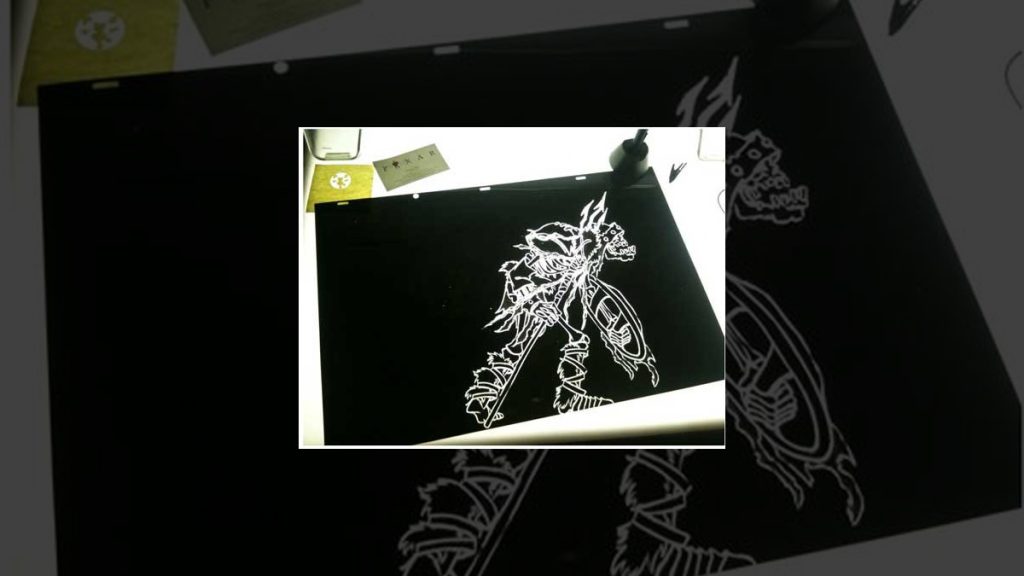I didn’t work on Disney’s “The Black Cauldron,” so you’ll
gain no film-making insights from me this time around. Oddly enough, this was a
very important film for The Walt Disney Company. And although it didn’t exactly
burn up the box office charts when it opened, “The Black Cauldron” served an
even greater purpose. However, we’ll get to that later.
What I did find interesting back in the early 1980s was a
change in attitude at Disney’s animation department. Curious about the film, I
thought I might stop in for a chat with animation boss Ed Hansen. I had known Ed for years while
working at the Studio. Ed was Woolie‘s assistant for many years before taking
on the position of animation manager. What I found odd was the fact that Ed
acted as though he hardly knew me and seemed reluctant to let me on the Disney
lot for an interview. He told me to check back later because Disney CEO Ron
Miller hadn’t seen the movie.
An original cel from this Disney motion picture. It’s one of the “Cauldron Born.” A cel shot
in negative to be “burned” into the film
Eventually, I was granted an interview and I found myself
back inside Walt’s magic kingdom. I confess the Disney Studio felt weird
because young artists now filled the animation building and most had been
recently hired. The young staffers displayed an odd arrogance and behaved as
though they were “old Disney veterans.” Some even proceeded to lecture me on “How
we make pictures.” Were they clueless, I wondered? I was working at Disney when
most of them were still in middle school.
“The Black Cauldron” continued to garner a fair amount of
media attention even though the movie struggled in development. The studio knew
it needed a refresh after a number of lackluster films failed to attract much
box office attention. The lure of pixie dust and Disney feature film-making was
compelling enough to warrant a return visit to the Mouse House. I knew Disney
was touting their new production and they hoped that this animated experiment
would be a breakthrough motion picture. I eagerly headed upstairs to the second
floor for a look at what I hoped would be awesome artwork.
Early “Black Cauldron” development art like this was kept under lock and key. So no
looky-loos
Having made my way to the Animation Building’s second floor,
I wandered about looking for what I knew would be a treasure trove of cool
layouts and backgrounds. Much to my surprise there wasn’t a thing in sight. I
entered one of the second floor wings only to find the inner door locked. Where
was I, I wondered? Was this the Walt Disney Studio or Washington DC’s Pentagon?
Eventually, I asked a passing artist about the film’s backgrounds. “We don’t
want the artwork in view,” he replied. It’s much too valuable. “Too valuable to
have on display?,” I considered. I couldn’t help but remember when Eyvind Earle‘s awe-inspiring
backgrounds for “Sleeping Beauty” were on view everywhere. Now, this
Disney art was too precious to even have on display? Excuse me, but I couldn’t
help thinking “Give me a break!”
I was never accepted for a position on “The Black
Cauldron’s” fledgling animation team. So I returned to my television gig making
bad Saturday morning cartoons. However, a few years later, I was asked to
joined Disney’s publishing department as an editor. And that turned out to be
one of the best jobs I ever had.
The new movie boss was not exactly familiar with the Disney animation process.
This probably made things a little tense
Being back in the Disney family meant I could attend
screenings of the ill-fated animated feature, and each new screening grew
successively worse. The directors began shifting the order of sequences as if
that would garner a more compelling narrative. Sadly, nothing appeared to help,
and the arrival of new Disney management in 1984 only drove the nail deeper.
The studio finally released “The Black Cauldron” with little fanfare and
audiences had zero interest in the dark, dreary Disney motion picture.
Cheer up, because this sad, animated story has a silver
lining. Remember all those green, young animation artists I mentioned early on?
Many of them had never worked on a Disney feature film before. “The Black
Cauldron” provided an excellent training vehicle and scores of young animators
and assistants developed their chops while working on the movie. Of course, you
already know what happened next. An animation renaissance was on the horizon
and Disney’s revitalized animation department would never look back.
I saved the original “Black Cauldron” press kit from when this film was first released to
theaters. It’s still in great condition (The press kit. Not the movie).
Did you enjoy today’s tale from Floyd Norman? Well, if you’d
like to learn more about the many amazing & amusing adventures that this
Disney Legend has had over the course of the 40+ years that he’s worked in the
animation industry, then you definitely want to check out some of the books
which Mr. Norman has written.
Floyd’s most recent effort – “Disk Drive: Animated
Humor in the Digital Age” – is available for purchase through blurb.com.
While Mr. Norman’s original collection of cartoons and stories — “Faster!
Cheaper! The Flip Side of the Art of Animation” – is still for sale over
at John Cawley‘s Cataroo. And if you still haven’t had your fill of Floyd, feel
free to move on over to Mr. Fun. Which is where Mr. Norman posts his musings
when he’s not writing for JHM.
